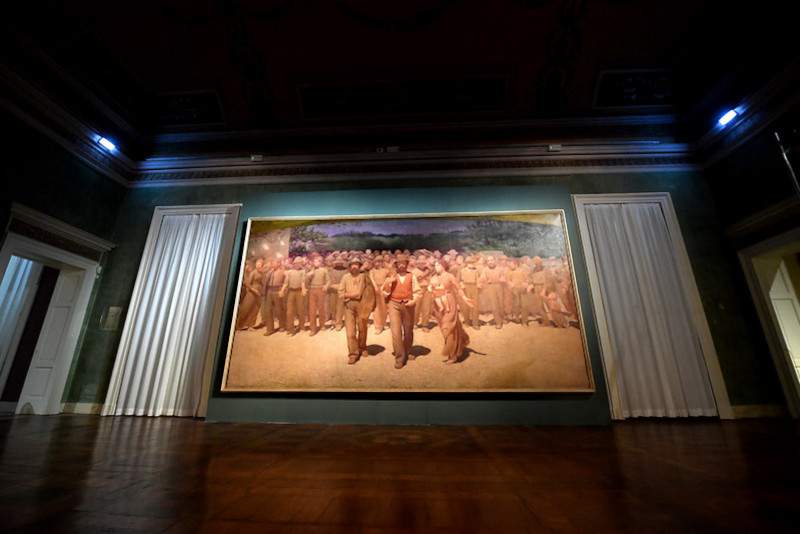From Thursday, July 7, Giuseppe Pellizza da Volpedo ’s Il Quarto Stato (The Fourth Estate ) returns once again to the permanent collections itinerary on the second floor of the Galleria d’Arte Moderna in Milan. The painting thus returns permanently to GAM after being exhibited since 2010 at the Museo del Novecento, and a new display has been created for the occasion.
"We are happy that The Fourth Estate has returned home, with a new display that enhances its pictorial quality and disruptive power, and with a closeness on the part of the visitor that allows an exciting direct relationship with the masterpiece," said Culture Councillor Tommaso Sacchi. “I thank Banco BPM for its enthusiastic support of this cultural operation, destined to mark a fundamental step in the history of the Gallery of Modern Art.”
The new location has been designed to make the work visible in the best possible conditions, both from a distance that restores its impressive formal setting and from a closer position, which will give visitors the opportunity to admire the artist’s extraordinary painting technique. The dialogue between this room and the adjacent Ballroom also allows for a series of framing intended to enhance the scenic power of the painting.
Displayed between the room dedicated to Segantini and the one dedicated to Previati, where Maternity, from the Banco BPM collection, recently granted on loan for the next three years, is visible, Il Quarto Stato finds here an appropriate collocation also from a chronological point of view, placing it in continuity and dialogue with the surrounding works, in a path that summarizes, through a series of masterpieces, the transition from the nineteenth to the twentieth century.
The remounting of the painting was made possible thanks to the contribution of Banco BPM.
“Just a few weeks after the event that saw us inaugurate a fruitful collaboration with the City of Milan through the concession of Gaetano Previati’s Maternità for the next three years, we are proud to continue with our support for the new exhibition display of Pellizza da Volpedo’s Quarto Stato, also here at GAM,” commented Umberto Ambrosoli, chairman of Fondazione BPM and Banca Aletti. “Both pivotal works of Divisionism, the Fourth Estate stands in the wake of Previati’s Maternity to surpass it and pave the way for the twentieth century, for a new way of symbolically understanding artistic expression and thus inaugurate a new era. Banco BPM has always paid special attention to the promotion of cultural heritage, including through collaboration with institutions and local authorities, aware that investing in culture, sharing prestigious works that represent excellence in our national artistic history, means encouraging social as well as economic progress. With this new collaboration with the Municipality of Milan and the Gallery of Modern Art, we confirm our support for initiatives that contribute to increasing the cultural background of citizens and spreading beauty and culture.”
The scene, set in a square in the painter’s hometown, depicts the protest of a group of workers whose march toward a bright future claims the cohesive strength and dignity of labor from which the redemption of the people must begin. It is a monumental painting that Pellizza worked on between 1898 and 1901, years characterized by strikes, protests and claims of the working class, for which the painting is a mouthpiece.
The creation of the painting required the painter a long period of study that lasted ten years. In fact, three earlier versions are known: Ambassadors of Hunger (1892), Fiumana (1895) and The Workers’ Walk (1899) close to the final work, which the painter, inspired byJean Jaurès ’ writings on the French Revolution, would title The Fourth Estate.
Presented to the public at the 1902 Quadriennale in Turin, the painting remained unsold but quickly became a celebrated and reproduced symbol. In 1920, in the incandescent climate of the Red Biennium, The Fourth Estate reached Milan for a monographic exhibition at the Pesaro Gallery. It aroused such an outcry that a public subscription was promoted to secure the canvas for the city, which in fact found a home in the Sala della Balla in the Castello Sforzesco and then moved to the Gallery of Modern Art in the present site of the Villa Reale.
After World War II, the painting was moved to Palazzo Marino, the seat of City Hall, as a symbol of the conquest of democracy and the reappropriation of rights. In 1979 it was chosen by Bernardo Bertolucci as the incipit of the film Novecento.
Rediscovered as a masterpiece of Italian painting at the same time as Divisionism studies were flourishing and exhibited in London and Washington, the painting returned to museum rooms in 1980. After a decade at the new Museo del Novecento opened in 2010, the monumental masterpiece now returns to the Gallery of Modern Art.
 |
| The Fourth Estate returns to Milan's GAM with a new installation |
Warning: the translation into English of the original Italian article was created using automatic tools. We undertake to review all articles, but we do not guarantee the total absence of inaccuracies in the translation due to the program. You can find the original by clicking on the ITA button. If you find any mistake,please contact us.